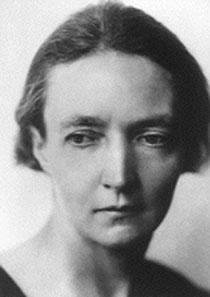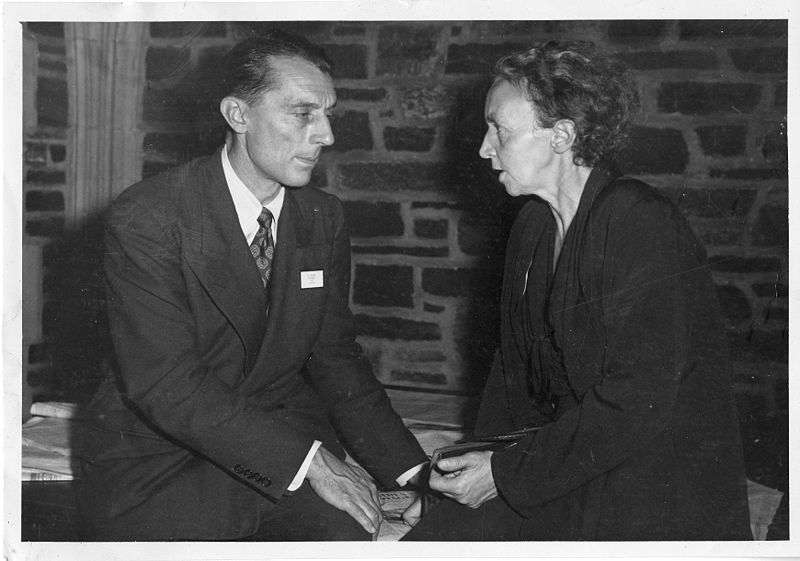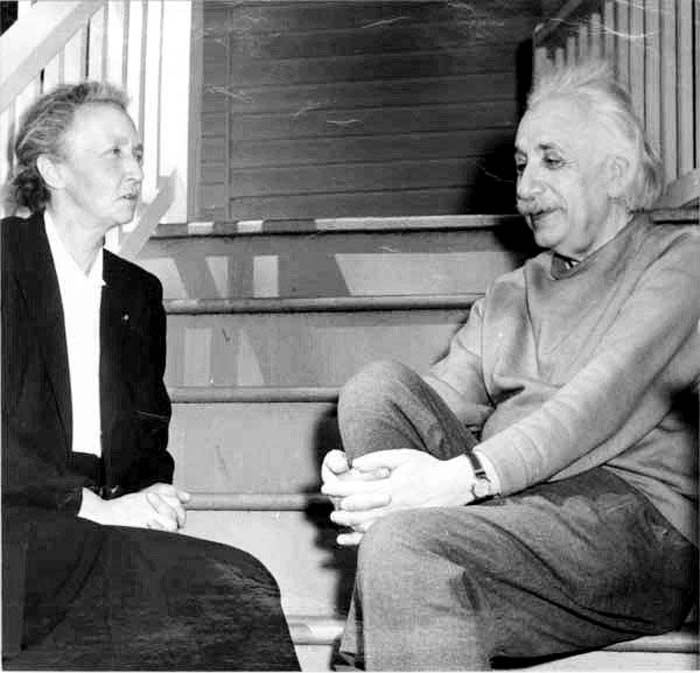<Back to Index>
- Chemist Irène Joliot-Curie, 1897
- Painter and Photographer George Hendrik Breitner, 1857
- Prime Minister of the United Kingdom Herbert Henry Asquith, 1852

Irène Joliot-Curie (12 September 1897 – 17 March 1956) was a French scientist, the daughter of Marie Skłodowska-Curie and Pierre Curie and the wife of Frédéric Joliot-Curie. Jointly with her husband, Joliot-Curie was awarded the Nobel Prize for chemistry in 1935 for their discovery of artificial radioactivity. This made the Curies the family with most Nobel laureates to date. Both children of the Joliot-Curies, Hélène and Pierre, are also esteemed scientists.
Joliot-Curie
was born in Paris. After a year of traditional education, which began
when she was 6 years old, her parents realized her obvious mathematical
talent and decided that Irène’s academic abilities needed a more
challenging environment. Marie joined forces with a number of eminent
French scholars, including the prominent French physicist Paul Langevin to form “The Cooperative,” a private gathering of some of the most distinguished academics in
France. Each contributed to educating one another’s children in their
respective homes. The curriculum of The Cooperative was varied and
included not only the principles of science and scientific research but
such diverse subjects as Chinese and sculpture and with great emphasis
placed on self expression and play. This arrangement lasted for two years after which Joliot-Curie re-entered a more orthodox learning environment at the Collège Sévigné in central Paris from 1912 to 1914 and then onto the Faculty of Science at the Sorbonne, to complete her Baccalaureat. Her studies at the Faculty of Science were interrupted by World War I. Initially, Joliot-Curie was taken by her mother to Brittany,
but a year later when she turned 18 she was re-united with her mother,
running the 20 mobile field hospitals that Marie had established. The
hospitals were equipped with primitive X-ray equipment made possible by
the Curies’ radiochemical research. This technology greatly assisted
doctors to locate shrapnel in wounded soldiers, but it was crude and
led to both Marie and Irène, who were serving as nurse
radiographers, to suffer large doses of radiation exposure. After
the War, Joliot-Curie returned to Paris to study at The Radium
Institute, which had been built by her parents. The institute was
completed in 1914 but remained empty during the war. Her doctoral
thesis was concerned with the alpha rays of polonium,
the second element discovered by her parents and named after Marie’s
country of birth, Poland. Joliot-Curie became Doctor of Science in 1925. As
she neared the end of her doctorate in 1924 she was asked to teach the
precise laboratory techniques required for radiochemical research to
the young chemical engineer Frédéric Joliot who she would later come to wed. From
1928 Joliot-Curie and husband Frédéric combined their
research interests on the study of atomic nuclei. Though their
experiments identified both the positron and the neutron, they failed
to interpret the significance of the results and the discoveries were
later claimed by C.D. Anderson and James Chadwick respectively. These
discoveries would have secured greatness indeed, as together with J.J. Thomson's discovery of the electron in 1897, they finally replaced Dalton’s theory of atoms being solid spherical particles. Finally,
in 1934 they made the discovery that sealed their place in scientific
history. Building on the work of Marie and Pierre, who had isolated
naturally occurring radioactive elements, Joliot-Curies realised the
alchemist’s dream of turning one element into another, creating
radioactive nitrogen from boron and then radioactive isotopes of phosphorus from aluminium and silicon from magnesium. For example irradiating the main natural and stable isotope of aluminum with alpha particles (i.e. helium nuclei) results in an unstable isotope of phosphorus : 27Al + 4He > 30P + 1n.
By now the application of radioactive materials for use in medicine was
growing and this discovery led to an ability to create radioactive
materials quickly, cheaply and plentifully. The Nobel Prize for
chemistry in 1935 brought with it fame and recognition from the
scientific community and Joliot-Curie was awarded a professorship at
the Faculty of Science. Irène’s
group pioneered research into radium nuclei that led a separate group
of German physicists to discover nuclear fission; the splitting of the
nucleus itself and the vast amounts of energy emitted as a result. The years of working so closely with such deadly materials finally caught up with Joliot-Curie and she was diagnosed with leukemia. She had been accidentally exposed to polonium when
a sealed capsule of the element exploded on her laboratory bench in
1946. Treatment with antibiotics and a series of operations did relieve
her suffering temporarily but her condition continued to deteriorate.
Despite this Joliot-Curie continued to work and in 1955 drew up plans
for new physics laboratories at the Universitie d’Orsay, South of Paris. The
Joliot-Curies had become increasingly aware of the growth of the
fascist movement. They opposed its ideals and joined the Socialist Party in 1934, the Comité de Vigilance des Intellectuels Antifascistes a year later, and in 1936 actively supported the Republicans in the Spanish Civil War.
In the same year, Joliot-Curie was appointed Undersecretary of State
for Scientific Research for the French government where she helped in
founding the Centre National de la Recherche Scientifique. The
Joliot-Curies had continued Pierre and Marie’s policy of publishing all
of their work for the benefit of the global scientific community, but
afraid of the danger that might result should it be developed for
military use, they stopped. On 30 October 1939 they placed all of their
documentation on nuclear fission in the vaults of the Académie
des Sciences where it remained until 1949. Joliot-Curie's
political career continued after the war and she became a commissioner
in the Commissariat à l'énergie Atomique. However, she
still found time for scientific work and in 1946 became director of her
mother’s Institut du Radium, Radium Institute. Joliot-Curie
became actively involved in promoting women’s education, serving on the
National Committee of the Union of French Women (Comité National de l'Union des Femmes Françaises) and the World Peace Council. Joliot-Curies were given memberships to the French Légion d'honneur; Irène as an officer and Frederic as a commissioner, recognising his earlier work for the resistance. Irène
and Frédéric hyphenated their surnames to Joliot-Curie
after they married 1926. Eleven months later, their daughter Hélène was born, who would also become a noted physicist. Their son, Pierre, a biologist, was born in 1932. During World War II Joliot-Curie
contracted tuberculosis and was forced to spend the next few years
convalescing in Switzerland. Concern for her own health together with
the anguish of leaving her husband and children in occupied France was
hard to bear and she did make several dangerous visits back to France,
enduring detention by German troops at the Swiss border on more than
one occasion. Finally, in 1944 Joliot-Curie judged it too dangerous for
her family to remain in France and she took her children back to
Switzerland. In
1956, after a final convalescent period in the French Alps,
Joliot-Curie was admitted to the Curie hospital in Paris where she died
on 17 March at the age of 58 from leukemia. Joliot-Curie's daughter, Hélène Langevin-Joliot, is a nuclear physicist and professor at the University of Paris; her son, Pierre Joliot, is a biochemist at Centre National de la Recherche Scientifique.

